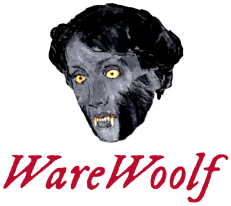-
Notifications
You must be signed in to change notification settings - Fork 3
Home

v0.9.0 (beta)
"The only writing software I use." -Virginia Woolf
WareWoolf is designed for one thing: writing fiction. It is intentionally simplified: you cannot change the font, line spacing, or color. But it has everything you need to organize, edit, and revise a novel--and you don't even need a mouse.
It is composed of three simple text-based panels with no icons: Chapters, Editor, and Notes.
That's it. There is no toolbar with twenty buttons cluttering the screen. There isn't even a file menu unless you summon it. All formatting is done with shortcuts. (But don't worry, there aren't many to memorize, and you can always press CTRL + H to show them all in the Shortcut Helper. It's not like you do a lot of formatting when writing fiction anyway.)
What it does have is an array of tools for importing plaintext files and converting them into proper manuscript format, as well as features such as self-emailing drafts at the press of a button for easy use in standalone writing devices ("writerDecks") without access to any other software.

- All-keyboard navigation designed for pleasant use without a mouse
- Distraction-free writing: Each of the three panels can be toggled on/off at the press of a button. Write with only your manuscript visible.
- Plain text import/conversion tools
- Options to parse a simplified version of Markdown (MarkdownFic) or interpret custom markers for detecting italics, headings, etc.
- Detect custom strings marking chapter breaks or break text into chapters at each heading, etc.
- Easily re-order chapters and automatically re-number them in headings after doing so ("Chapter One," "Chapter Two," etc.)
- Compile chapters into single manuscript or export into individual files for each chapter
- Send Via Email: Email drafts of individual chapters or the entire manuscript to yourself at the press of a button.
- Word Counts / Goal: See total count, chapter count, session count, and set a goal to see a progress bar showing how close you are to completion.
- Each chapter is saved as an individual file only loaded when you are working on that chapter. This keeps very long novels from slowing the application at all, even with low-memory computers such as a Raspberry Pi.
- Outliner (very simple as is, but plan to improve drastically)
- Adjust width of text editor and how large text is displayed.
- Spellcheck, but it must be run after writing (no form of auto-correct or red squiggles or godawful grammar advice).
On the left is the list of chapters, which you can re-order and rename. In the middle, the main editor. On the right, notes. These three panels can each be toggled on/off with F1, F2, and F3, so you can clear everything but the editor for a fully distraction-free experience, or make room for using a narrow vertical screen.
Speaking of room--the editor panel can be contracted or expanded using CTRL + < or > so you can see your paragraphs as they will look in a narrow paperback or a wide manuscript page. Similarly, you can adjust the font display size with CTRL + - or +.
To cycle through chapters, press CTRL + Up or Down. CTRL + Right and Left will jump between the notes and main editor. These are the Navigation Keys.
To move a chapter up or down in the list, press CTRL + SHIFT + Up or Down. To rename a chapter, CTRL + SHIFT + Left. These are the Alteration Keys.
Pressing ALT will reveal the file menu. Here you can import, export, compile, or use many other tools, all easily accessible without a mouse by navigating the menus with the Arrow Keys and Escape. In addition to the usual find/replace, spellcheck, etc., there is a simple Outliner with word count breakdowns for each chapter and a fields for writing summaries.
WareWoolf makes it easy to combine multiple files, edit and style them, and export them as a document in standard manuscript format.
It is designed especially to work well for those who write first drafts in plain-text-based workflows, as is common with distraction-free writing devices such as the Astrohaus Freewrite, Alphasmart Neo, or various stripped-down applications.
Binaries of the current release for Windows, Debian AMD64, and Debian ARM64 (Raspberry Pi) are available in the releases page.
This app was built using Electron Forge. To run it from source...
- You must first have Node.js installed.
- Run "npm install" in the WareWoolf source code directory to install the dependencies using the Node Package Manager, or however you like.
- Then you can simply use command "npm start" to run the program.
- To make a binary, "npm run make". See the Electron Forge documentation for instructions on how to alter the package.json file for making binaries for different systems, but basically in the "makers" property of the "forge" object in the package.json file, there is an array of different makers for producing different binaries. The "@electron-forge/maker-squirrel" is for producing a Windows binary, the maker-deb for Debian, and the maker-rpm for Redhat. To produce one, delete the other two from the file before running "npm run make". You will find the binary in the "out" folder.